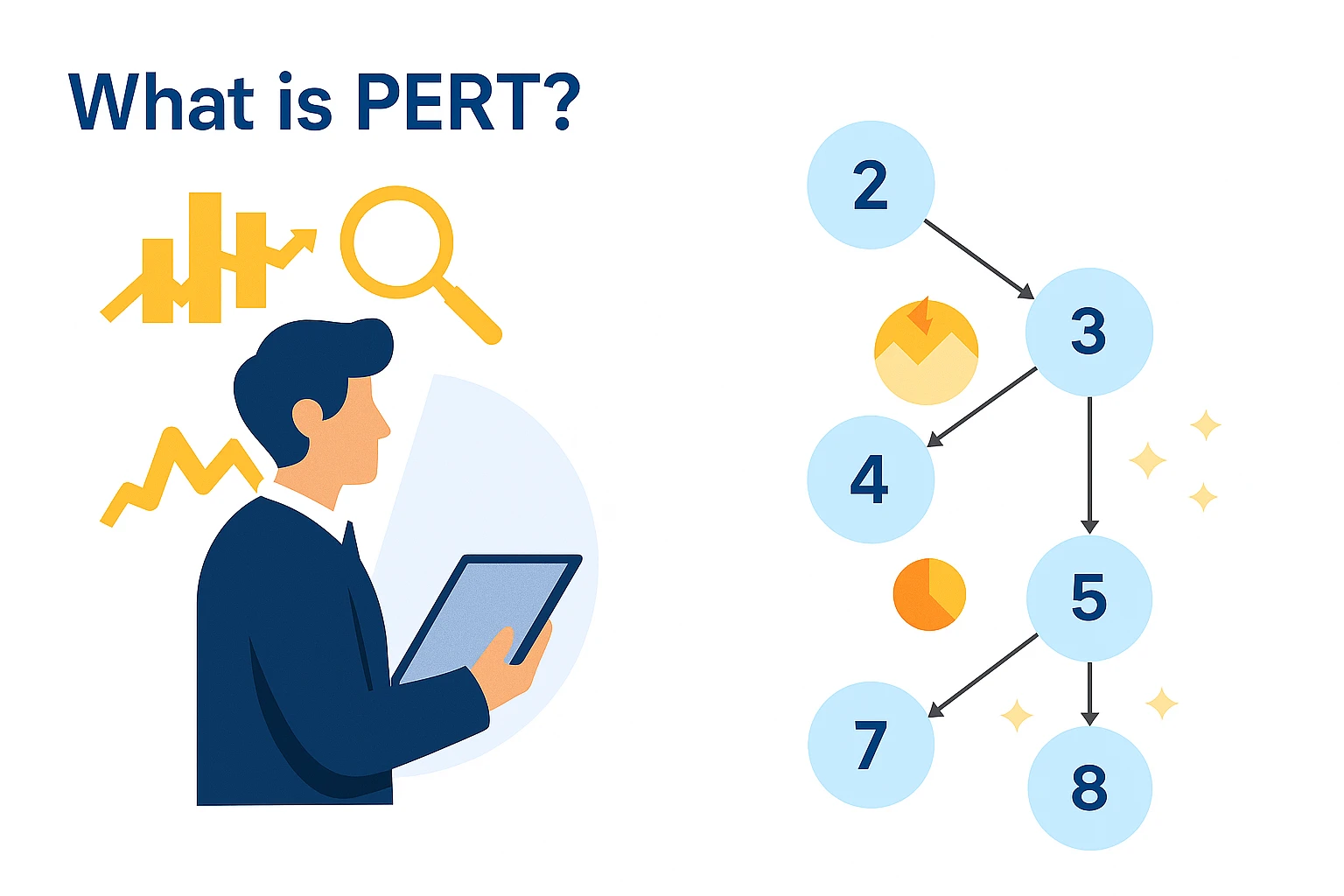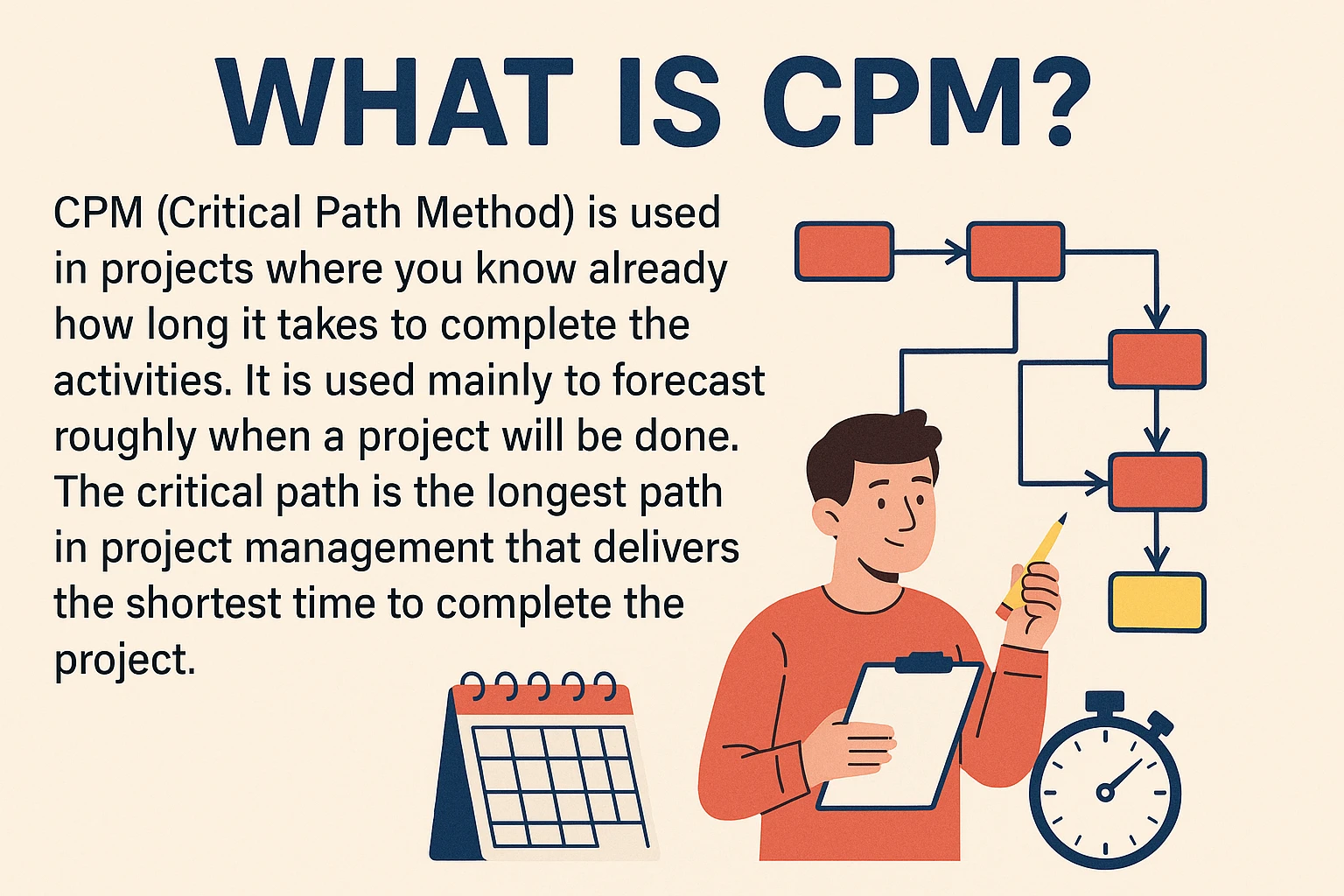Difference Between PERT and CPM in Project Management
Table of Contents

- jaro Education
- 3, August 2024
- 9:00 pm
When they undertake effective project management, many professionals use some of the same strategic techniques to enhance their resources, time, and money when they can. Arguably, the most famous techniques would be PERT (Program Evaluation and Review Technique) and CPM (Critical Path Method). Although both of these tools assist project managers in planning, scheduling, and controlling the activities in a project environment, they have some very different applications and approaches.
In this blog, we review the difference between PERT and CPM, the best use of each, and ultimately guide you to determine the best technique for your project needs.
CPM and PERT full form
The CPM and PERT full form helps clarify the core focus of each method:
PERT Full Form: Program Evaluation and Review Technique
CPM Full Form: Critical Path Method
These full forms indicate that while PERT focuses on evaluation and time estimation, CPM focuses on finding the critical path to optimize execution.
What is PERT and CPM?
What is PERT?
PERT stands for project evaluation and review technique. This is a technique to be used for projects where the time needed or taken to complete different activities is unknown. It is used as a thinking tool to figure out the time required to realistically finish a project. It provides a picture of the project and is an effective way to evaluate a project.

In this method, you develop a PERT chart, which is a schedule of all of the identified tasks in the project. The PERT chart shows the organization and coordination of the tasks in the project. You can then establish a critical path from the PERT chart. The critical path includes any critical activities that have to be done on schedule.
What is CPM?
CPM (Critical Path Method ) is a method is used in projects where you know already how long it takes to complete the activities . It is used mainly to forecast roughly when a project will be done. The critical path is the longest path in project management that delivers the shortest time to complete the project.

CPM helps project managers identify taken as critical and non-critical; this helps project managers to prioritize resources and maintain project scheduling.
How PERT and CPM are Used in the Real World
The difference between PERT and CPM in operations research is also highlighted through their real-world application difference between PERT and CPM. The PERT has been a go-to tool in industries like aerospace and defense, where projects are complex and involve significant uncertainty. For instance, NASA has utilized PERT for planning and executing space missions, where precise timelines are challenging to determine but crucial for success.
Conversely, CPM has proven invaluable in construction and infrastructure projects, where the sequence of activities and their durations are well known. For example, major construction projects, such as building skyscrapers or bridges, often use CPM to ensure that every phase is completed on schedule and within budget. This practical difference between PERT and CPM in operations research showcases their effectiveness in different project environments.
Applications of PERT:
- Research and Development Projects: Difference Between PERT and CPM but PERT is most effective in projects like Research and Development in which the duration of tasks is very uncertain. The method predicts the time frame of the project with reference to various scenarios, such as optimistic, pessimistic, and most likely times.
- Large and Complex Projects: The PERT application is very common in projects requiring a large number of interdependent activities. It also provides information on how to measure project timelines well and find critical tasks that need to be paid attention to.
- Government and Defense Projects: Of course, because it was originally invented by the U.S. Navy, government and defense projects would normally use PERT, where it becomes difficult to predict the length and complexity of the tasks.
- Construction Projects: PERT is similarly applied in large-scale construction projects, wherein uncertainties related to the weather, resource availability, and completion times exist.
Applications of CPM:
- Construction Projects: Difference Between PERT and CPM but CPM is most widely applied in construction projects where activities tend to have fixed durations and depend on well-defined relationships. The process will enable project managers to have optimal resources and effective temporal use of the project.
- Manufacturing: In the execution of manufacturing projects, where tasks such as assembling lines, schedules for production, and breakdown maintenance are well-defined, there is a need for close coordination of activities. CPM is very effective for that.
- Software Development: On the other hand, CPM can be effectively used when predictable development processes are involved and the main goal is to achieve the project within its schedule and optimal resources.
- Event Planning: Difference Between PERT and CPM but CPM can also be utilized in event planning, where each task (such as securing permits, booking vendors, and setting up venues) has a fixed duration, and the aim is to identify and manage the critical path.
Why Are PERT and CPM Important in Operations Research?
PERT in Operations Research
Risk Analysis: After having a lot of differences between PERT and CPM but PERT also collects and saves probabilities, which can help assess the impact of risks and uncertainty on project completion times. By calculating expected time and estimating different possible conditions, OR experts can devise risk management strategies.
Decision Making: In operations research, by PERT, project decision-making can be framed concerning uncertain outcomes, thus providing the basis for management decision-making in terms of the best, worst, and most likely scenarios.
Simulation: PERT is used in Monte Carlo simulation modeling for the representation of the behavior of complex systems under uncertain conditions, thus making it a part and parcel of operations research in risk analysis.
CPM in Operations Research
Optimization: CPM is one of the operations research techniques to shorten project duration and resource usage. The more it focuses on critical path analysis, the more it helps to get based on critical tasks that would require some added resources or attention to avoid project delay.
Resource Allocation: CPM manages optimal allocation of manpower, machinery, and materials in order to get the work done on time and make efficient use of available resources.
Cost Minimization: Integrating into CPM in most cases with cost analysis, operations research techniques can be used to find the most cost-effective way of constructing schedules while ensuring that the system works as efficiently as possible.
Hence, the Difference Between PERT and CPM is still there apart from the operations research.
Difference Between PERT and CPM in Project Planning
The distinction between PERT and CPM lies most strongly in how they each model project planning.
PERT in Planning
Best suited for projects with variable task durations.
Commonly used in research, software development, and new product development.
Involves probabilistic time estimates.
CPM in Planning
Best suited for projects with fixed and predictable tasks.
Common in construction, engineering, and manufacturing.
Uses fixed and deterministic time estimates.
So, before deciding, ask “Is my project more predictable or uncertain in nature?” That will help you decide between PERT and CPM.
CPM and PERT Difference in Time and Cost Management
One important difference between CPM and PERT is in the focus on the management of time and cost.
PERT – Time-Oriented
Used mainly to determine the duration of the project when there’s uncertainty around activities.
Does not contain an explicit analysis of direct costs.
Good to be used early in the project to understand risk and perform high-level estimates.
CPM – Cost and Time Oriented
Aims to optimize duration and overall project costs.
Includes methods such as crashing and fast tracking to reduce time on the project without significantly increasing cost.
Difference Between PERT and CPM: Advantages and Disadvantages
When you manage any kind of project, it is important to choose the correct manner of planning and scheduling, so you can stay accountable. That is difference between PERT and CPM is so valuable. But what exactly is PERT and CPM? And what is the difference? Knowing the difference between PERT and CPM may help project managers schedule their projects better if the tasks and deadlines are complex.
Both tools are widely utilized in the field of project management; however, they are also used for different reasons. The CPM and PERT difference is mainly formed around their role regarding time and uncertainties. In this guide, we will look at the difference between PERT and CPM, define the PERT and CPM full form, explain their distinct pros and cons, as well as assist the reader with deciding which method is best for their project.
| Method | Advantages | Disadvantages |
| PERT | Handles uncertain activities well- Great for new or research projects- Encourages planning | Complex calculations- Not suitable for routine tasks- Less focus on cost |
| CPM | Suitable for recurring tasks- Focuses on both time & cost- Easy to use for stable projects | Not ideal for uncertain projects- Less flexible- Assumes fixed time estimates |
What is the Difference Between PERT and CPM?
In project management, choosing between PERT (Program Evaluation Review Technique) and CPM (Critical Path Method) depends on the nature and requirements of the project. Here’s a breakdown of the key differences between these two methodologies:
Understanding these distinctions helps project managers choose the right tool for their specific project needs, ensuring optimal planning and execution. Recognizing the difference between PERT and CPM in operations research can significantly impact how projects are managed and executed successfully.
| Feature | PERT (Program Evaluation and Review Technique) | CPM (Critical Path Method) |
| Definition | A technique used for planning and controlling time for uncertain activities. | A method used to schedule and control the time and cost of well-defined tasks. |
| Focus Area | Time-centric (used for time estimation) | Time and cost-centric (used for cost and time optimization) |
| Nature of Project | Research and development, new projects with uncertain activities | Construction, manufacturing—projects with well-known activities |
| Activity Type | Non-repetitive activities | Repetitive or routine activities |
| Time Estimation | Uses three time estimates: Optimistic, Pessimistic, and Most Likely | Uses a one-time estimate (deterministic) |
| Application | Applied where time estimation is uncertain | Applied where time and cost estimation are known |
| Critical Path Calculation | Probabilistic approach | Deterministic approach |
| Cost Consideration | Not directly considered | Cost is a major factor in planning |
| Focus | Focuses on minimizing the time | Focuses on minimizing both time and cost |
| Type of Model | Event-oriented network model (focuses on events/milestones) | Activity-oriented network model (focuses on tasks/activities) |
| Slack Management | Suitable for projects with high uncertainty and slack | Suitable for projects with known timelines and little slack |
| Project Control | Less control over cost | Better cost and time control |
| Used By | Research organizations, R&D departments | Construction firms, production teams |
Choosing Between PERT and CPM
Choosing between PERT and CPM in operations research depends on various factors, including the type of project, the level of uncertainty, complexity, and resource constraints. If you’re dealing with a project where tasks are not well-defined and time estimates are uncertain, like in R&D or new product development, PERT’s probabilistic approach can be a lifesaver. On the other hand, if your project involves repetitive, well-understood tasks, like in construction or manufacturing, CPM’s deterministic scheduling can help you manage resources more effectively and keep things on track. The difference between PERT and CPM in these scenarios guides the decision on which methodology to apply.
- When to Use PERT
PERT is ideal for projects characterized by high uncertainty and where time estimates can vary significantly. It’s particularly useful in scenarios like research and development, where you’re often exploring new territory and facing unknowns. PERT’s flexibility in handling uncertain timelines makes it an excellent choice for planning and evaluating potential risks. Understanding the difference between PERT and CPM in operations research in this context helps teams prepare for various outcomes and uncertainties.
- When to Use CPM
CPM shines in projects with well-defined activities and predictable timelines. It’s the go-to method for projects where timing is critical and delays can lead to significant costs, such as in construction, infrastructure, and manufacturing. CPM’s ability to identify the critical path—those essential tasks that must be completed on time to avoid delaying the entire project—makes it a powerful tool for ensuring projects are completed on schedule and within budget. The difference between PERT and CPM in this situation highlights CPM’s effectiveness in managing projects with clear and predictable timelines.
Enhancing Project Management Skills With Jaro Expertise
In the ever-evolving field of project management, staying ahead requires continuous learning and professional development. Advanced training and education not only enhance your skill set but also keep you updated on the latest methodologies and tools. This is crucial for tackling the increasingly complex challenges faced in project management across various industries.
Jaro Education is indeed the best, most trusted online higher education company in India. This Edtech company is the pioneer of the executive education industry, established in 2009, and has always been the first mover in the online executive education space. It aims to develop entrepreneurs and professionals from entry-level to C-Suite in every field and industry, offering executive education programs. Established as an organization that has changed the face of online education in India, Jaro Education has transformed the careers of over 3 lakh professionals in more than 15+ years across its more than 30 learning centres throughout India.
For those looking to deepen their understanding of project management techniques like difference between PERT and CPM, advanced programs such as the Executive Programme in Operations Management and Analytics by CEP, IIT Delhi, are invaluable. Offered by leading institutions, these programs cover a wide range of topics, including comprehensive project management methodologies, resource optimization, and advanced analytical techniques. This training equips professionals with the knowledge and skills needed to excel in managing complex projects.
Conclusion
In summary, difference between PERT and CPM in operations research are both powerful tools in the project manager’s toolkit, each with its strengths and best-use scenarios. PERT is your go-to for projects filled with uncertainty and variability, offering flexibility and improved risk assessment. In contrast, CPM is best suited for projects where precision and efficiency are paramount, providing clear timelines and resource allocation strategies.
Selecting the appropriate project management tool is crucial for the success of any project. Understanding the unique features and applications of difference between PERT and CPM in operations research helps project managers choose the best approach for their specific needs, ensuring that projects are completed on time, within scope, and on budget.
To stay competitive and effective in project management, it’s essential to continue learning and developing your skills. Exploring advanced courses and certifications, such as the Executive Programme in Operations Management and Analytics, can provide valuable insights and techniques to enhance your project management capabilities. Whether you’re new to the field or a seasoned professional, ongoing education is the key to success in navigating the complexities of modern project management.
Frequently Asked Questions
The primary difference is that PERT is used for projects with uncertain activity durations and relies on probabilistic time estimates, while CPM is used for well-defined projects with known durations and focuses on both time and cost optimization.
PERT is used when activity durations are uncertain, such as in R&D or product development. It helps estimate the expected time to complete tasks using three time estimates—optimistic, pessimistic, and most likely.
CPM is ideal for projects where task durations are known. It helps identify the critical path, allowing project managers to optimize time and cost and manage resources efficiently.
Yes, many complex projects use PERT in the planning phase to handle uncertainty and CPM in the execution phase to manage time and costs more precisely.
PERT: Program Evaluation and Review Technique
CPM: Critical Path Method
PERT is commonly used in research, IT development, and defense projects.
CPM is widely applied in construction, engineering, manufacturing, and infrastructure projects.
It depends on the project. Use PERT when dealing with uncertain tasks and CPM when project activities are well-defined and cost-sensitive.
Both are network-based project management tools, used to plan, schedule, and monitor project activities. They both identify the critical path and help optimize project timelines.
Yes. CPM includes cost analysis and can be used for cost optimization, while PERT focuses only on time estimation.
In Operations Research, both tools help solve scheduling, resource allocation, and time optimization problems, improving overall decision-making in complex projects.
Recent Blogs
It seems we can't find what you're looking for.







